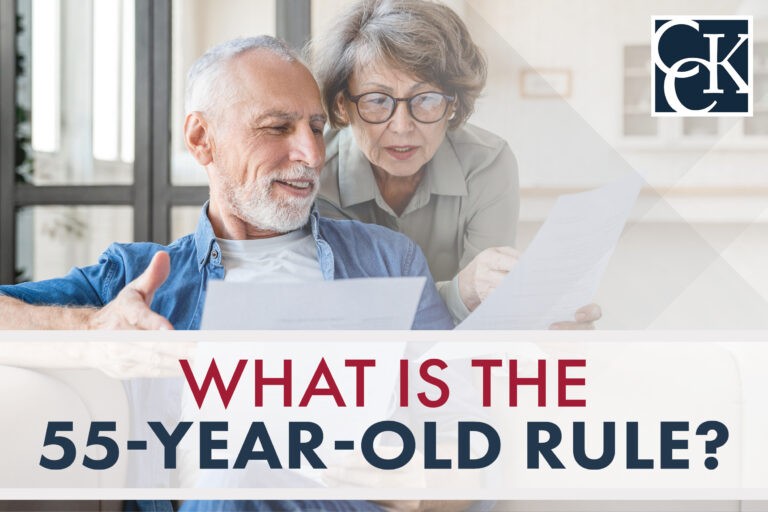What Is the 55-Year-Old Rule?

CCK Law: Our Vital Role in Veterans Law
Any veteran approaching 55 years old and researching VA disability benefits is likely to hear about the “55-year-old rule.” This rule is often cited as a way to protect a veteran’s VA disability rating, ensuring that it cannot be changed.
Unfortunately, this policy is frequently misunderstood even among some veterans advocates. In this article, we will explain the source of the confusion and provide guidance for veterans researching how to protect their VA disability rating.
How VA Describes the 55-Year-Old Rule
Typically, when VA issues a disability rating to any veteran, it then schedules periodic Compensation & Pension (C&P) exams, usually for every two to five years. If VA finds during these C&P exams that the veteran’s condition has changed, then VA may increase or reduce their disability rating accordingly.

However, VA’s Compensation and Pension Manual — specifically M21-1, Part IV, Subpart ii, Chapter 1, Section A — states that “If the Veteran will have reached or surpassed age 55 by the time the reexamination is conducted, then do not schedule the reexamination unless required to do so by specific regulation, or compelled to do so based on unusual circumstances.”
Why the 55-Year-Old Rule Is Confusing
If VA stops scheduling automatic reevaluations for veterans who will be aged 55 or older at the time of the exam, then many advocates and veterans infer that the veteran’s rating is now “protected,” or safe from being changed.
A few veterans and advocates have even erred by taking this a step further, arguing that if a veteran’s rating cannot change after 55, then veterans cannot file claims for new or revised VA benefits, either.
However, this is not what the rule states. Unlike actual rating protections, the 55-year-old rule only limits routine reexaminations, not changes to the rating itself.
How the 55-Year-Old Rule Fails to Protect VA Ratings
It is important for veterans to remember that recurring C&P exams are only one of the ways to trigger a ratings reevaluation. We have found that VA may also reevaluate ratings in situations like the following:
- A veteran opens a new claim to add Special Monthly Compensation, Specially Adapted Housing or Special Housing Adaptation, or a secondary condition caused by their primary disability
- A veteran has surgery related to a service-connected disability
- The disability is one of certain infectious diseases that change over time
Another major caveat is that VA has not yet defined the “unusual circumstances” that allow reexamination of veterans over 55, beyond saying that this “is an individual, fact-specific determination left to the discretion of the rating activity.”
Once VA decides to conduct an exam for any reason, it may also reevaluate the veteran’s existing conditions, barring a specific law or regulation blocking it, which the 55-year-old rule does not. Therefore, it would be inaccurate to describe the 55-year-old rule as a true rating protection.
Alternative Rating Protections for Veterans Over 55
The 55-year-old rule may result in a more consistent rating on a case-by-case basis, but there are a number of actual rating protections that might provide more stability to veterans over 55 years old. Examples include but are not limited to the following:
- 5-year rule: Any rating that has remained at the same level for five years or longer is considered stabilized. VA cannot reduce a stabilized rating unless the condition shows sustained improvement over time.
- The VA disability 10-year rule states that while VA can reduce a veteran’s rating by providing substantial medical evidence suggesting steady improvement over time, it cannot fully eliminate a disability rating that has been in place for at least 10 years unless there is evidence of fraud.
- 20-year rule: Service-connected conditions that VA has rated at or above a certain disability rating level for 20 years or longer are considered continuous. VA cannot reduce a continuous rating below the original rating level unless the rating was based on fraud.
- 100 percent VA ratings: If VA assigns a veteran a 100 percent rating, VA cannot reduce the rating unless material evidence shows a significant improvement in the veteran’s ability to function on a day-to-day basis.
What If VA Reduces Your Disability Rating?
Before reducing a veteran’s rating, VA must send the veteran a letter proposing a reduction of benefits. The veteran then has a limited window in which to challenge the rating reduction. Next, VA will submit a final decision, which the veteran can appeal in several ways.
If you find yourself needing to appeal a rating reduction, consider reaching out to Chisholm Chisholm & Kilpatrick. We have argued many of the precedent-setting cases that have forced VA to better define vague rules and expedite claims. Please contact us for a free case evaluation.
About the Author
Share this Post
